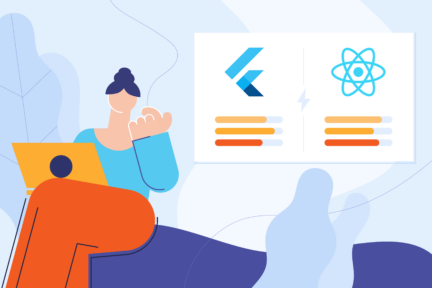Going mobile is the right direction for 2025 and onward, research suggests! So it’s only right that you’ve decided to invest in a mobile app of your own. But now some complicated questions may arise: should you insource or outsource, which platforms should you target, which programming language should you choose, etc.
Previously, we wrote a comprehensive piece on how to choose the right type of app for your business, and today, we are talking about languages. In particular, three of the most in-demand languages for mobile application development these days:
- Kotlin: Used for Android development, Kotlin is a statically typed programming language that runs on the Java Virtual Machine. It is known for its concise syntax, safety features, and seamless interoperability with Java. Kotlin has been officially supported by Google since 2017, making it the preferred language for modern Android apps.
- Swift: Designed for iOS programming, Swift is a powerful and intuitive programming language developed by Apple. It offers robust performance, security, and interactive development features, making it the go-to choice for iOS app developers. Swift’s modern syntax and ease of use have significantly reduced development time and improved code quality.
- Flutter: Bringing the best of both worlds through cross-platform development, Flutter SDK is an open-source UI software development toolkit created by Google. It allows developers to build natively compiled applications for mobile, web, and desktop from a single codebase. Flutter’s hot-reload feature, extensive widget library, and strong community support make it an attractive option for businesses looking to target multiple platforms with one codebase.
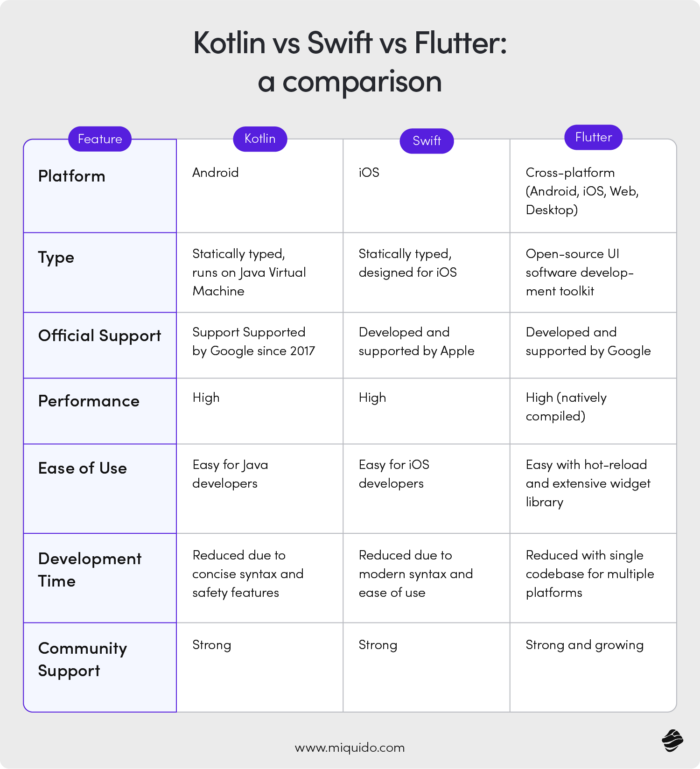
But before we proceed with this ultimate mobile comparison, let’s quickly recall the main differences between native and cross-platform app development.
Native vs cross-platform mobile app development
Choosing the right development approach is crucial for the success of your mobile app. When deciding between native and cross-platform development, it’s essential to understand their unique advantages and challenges.
Native apps are tailored to a specific operating system, offering optimal performance and user experience, while cross-platform apps provide the flexibility to reach a broader audience with a single codebase. In this section, we’ll delve into the specifics of each approach to help you determine the best fit for your business needs.
Swift vs Kotlin vs Flutter in App Development: Native apps
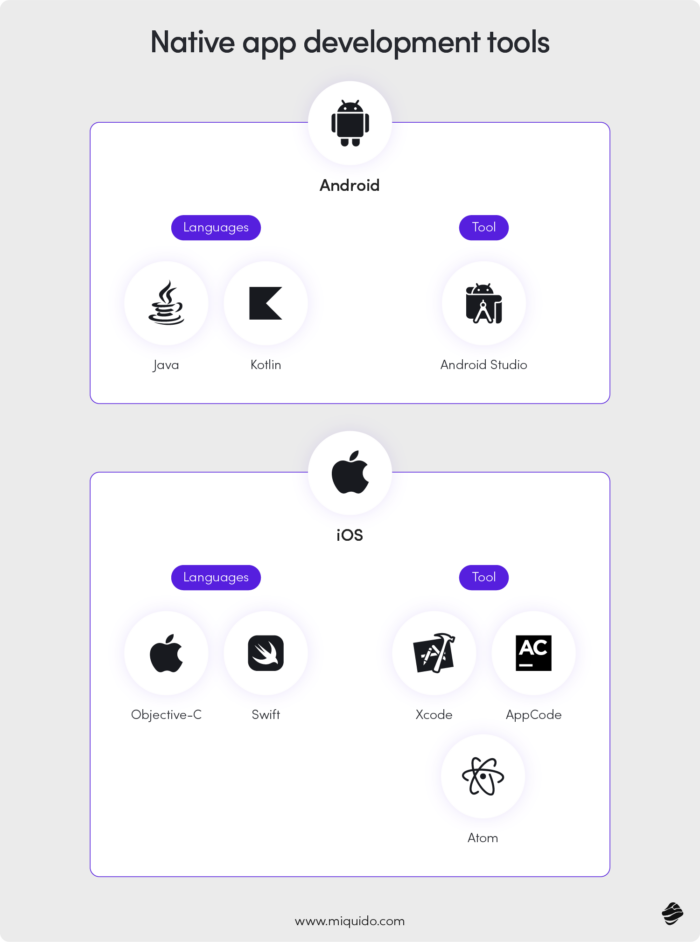
As the name suggests, native applications are bound to the platform they’re designed for. As such, if you write Android apps, it will only function on that operating system. And if you eventually decide to scale up and target Apple devices, your development team will have to write a new code for scratch.
This is why it’s paramount to know why you chose a certain operating system over another. Otherwise, you are risking your entire business.
A recent example of a successful native solution is Clubhouse, which initially launched exclusively for iOS. As the app’s popularity soared, they released an Android version to tap into the 70% of the global market that Android covers. However, if your target audience primarily uses Apple devices, focusing on a native iOS app can significantly reduce expenses and speed up time to market.
Swift vs Kotlin vs Flutter in App Development: Cross-platform apps
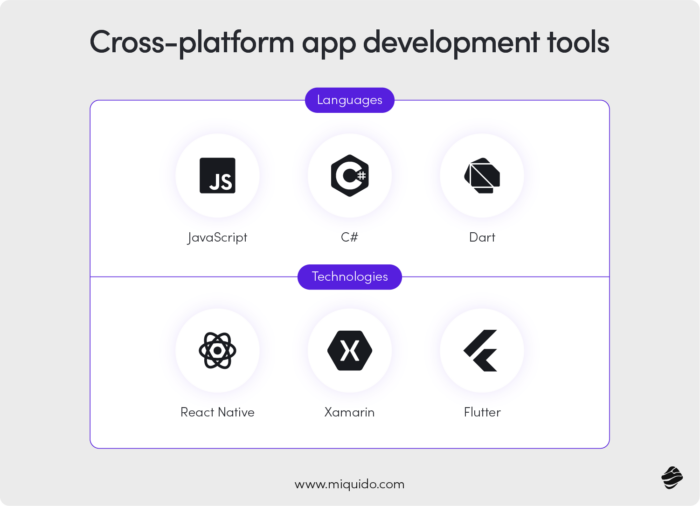
Cross-platform development allows you to create an app that looks and feels consistent on both iOS and Android devices. With Flutter, powered by the Dart programming language, you can build apps that seamlessly span various operating systems. This is ideal for businesses targeting general audiences or markets where both operating systems are equally represented.
Cross-platform is a safer option, yet it is also more costly and time-consuming than native app development, which is why you need to know exactly what you hope to achieve with your application in the end. That’s where knowing the key differences between the most popular programming languages for mobile comes into play.
Curious about cross-platform? Learn more about our cross-platform app development services and choose the right solution for your business!
Flutter vs Kotlin vs Swift: overview
In the fast-evolving world of mobile app development, choosing the right technology can significantly impact your project’s success. If you’re in a situation where the choice between native or cross-platform development won’t substantially affect your business’s profitability, it’s essential to consider the demands and capabilities of each technology.
Understanding the major advantages and disadvantages of Flutter, Kotlin, and Swift will provide valuable insights into which language might best meet your development needs and business goals.
Supported platforms and operating systems
| Swift | Kotlin | Flutter |
|---|---|---|
| iOS iPadOS MacOS WatchOS tvOS CarPlay | Android OS Wear OS Android TV Android Auto Kotlin Multiplatform Server-side development Desktop Scripting Web frontend development Data science | iOS Android Web macOS Windows Linux Fuchsia Custom embedded systems |
Flutter: Cross-Platform Flexibility
As an open-source UI software development toolkit created by Google, Flutter enables developers to build natively compiled applications for mobile, web, and desktop from a single codebase. This cross-platform framework is celebrated for its flexibility, allowing for seamless deployment across multiple platforms. Flutter’s hot-reload feature lets developers see code changes in real-time, significantly speeding up the development process.
Additionally, Flutter comes with an extensive widget library, facilitating the creation of highly customizable and visually appealing apps. However, as a relatively newer technology, Flutter’s ecosystem is still growing, which may occasionally pose challenges in finding comprehensive solutions or community support for specific issues.
Kotlin: Preferred for Modern Android Development
Kotlin is a statically typed programming language that runs on the Java Virtual Machine and is the preferred language for modern Android app development. Officially supported by Google since 2017, Kotlin offers concise syntax, strong safety features, and seamless interoperability with Java. These attributes make it an attractive option for developers familiar with Java, as it enhances productivity and reduces the likelihood of errors. Kotlin’s robust performance and compatibility with existing Java libraries ensure that developers can leverage a vast array of tools and resources.
However, Kotlin is primarily focused on Android, so businesses looking to target iOS users will need a separate development strategy, potentially increasing overall project costs and time.
Swift: Go-To for iOS Development
Swift, developed by Apple, is the go-to programming language for iOS development. Known for its powerful performance, security features, and interactive development capabilities, Swift has revolutionized the way developers create apps for the Apple ecosystem. Its modern syntax and ease of use have reduced development time and improved code quality, making it a favorite among iOS developers.
Swift’s integration with Xcode, Apple’s development environment, ensures a smooth and efficient workflow. While Swift is excellent for iOS development, its use is limited to Apple’s platforms, meaning separate strategies and resources are required for Android development.
Flutter vs Swift Performance
Comparing Flutter vs Swift performance, Swift naturally has the upper hand on iOS, given that it’s specifically designed by Apple for their ecosystem. Swift’s deep integration with Apple hardware and optimized performance features make it the top choice for projects focusing solely on iOS. Nevertheless, Flutter performs remarkably well across platforms, including iOS, and is optimized for delivering near-native performance, especially when targeting multiple devices. While Swift might edge out Flutter in terms of execution speed and efficiency for iOS-exclusive projects, Flutter’s cross-platform capabilities and fast UI rendering make it an appealing choice for applications that need to span both iOS and Android with minimal trade-offs in performance.
Key Considerations for Choosing Between Flutter, Kotlin, and Swift
When comparing Flutter, Kotlin, and Swift, it’s crucial to consider your target audience, development team’s expertise, and long-term maintenance plans. If your business aims to reach both Android and iOS users without significant additional costs, Flutter’s cross-platform capabilities make it an appealing choice.
On the other hand, if you need a high-performance, platform-specific app with deep integration into the operating system, Kotlin and Swift are unparalleled for Android and iOS development, respectively.
By evaluating the unique strengths and potential drawbacks of each technology, you can make an informed decision that aligns with your business objectives and ensures a successful mobile app development journey.
Curious about how these technologies can work for your project? Let’s explore each of them in detail!
iOS development with Swift
Swift is widely recognized as the best possible option for the Apple platform when it comes to quality and functionality. Developed by Apple, Swift was introduced in 2014 as a powerful and intuitive language for macOS, iOS, watchOS, tvOS, and beyond. With Swift, you can write a single codebase that works across all Apple devices, including mobile, tablet, desktop, wearables, and smart TVs, without sacrificing any functionality.
Swift’s modern syntax, safety features, and performance optimizations make it an ideal choice for developing robust and efficient iOS applications. The language is designed to be easy to read and write, reducing the likelihood of errors and making code maintenance simpler. Its interoperability with Objective-C also allows developers to integrate Swift into existing projects seamlessly.
Some popular apps built with Swift include LinkedIn, Kickstarter, Eventbrite, and more. These apps leverage Swift’s capabilities to provide smooth and responsive user experiences. At Miquido, we have embraced Swift for various projects, ensuring our clients receive top-quality, high-performing applications.
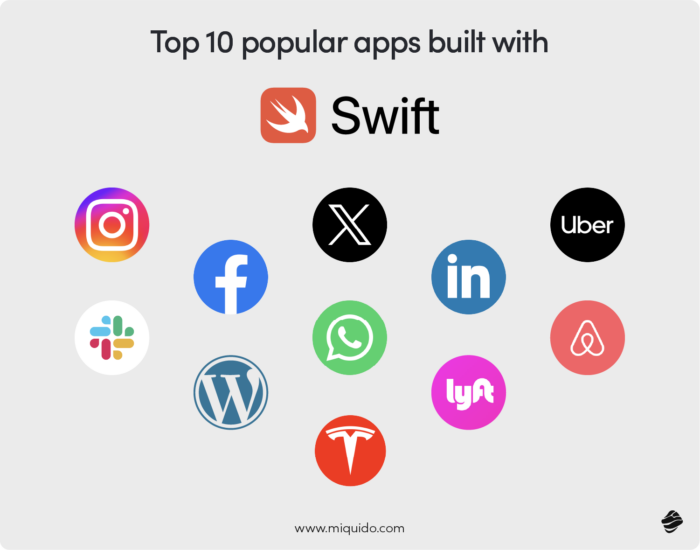
Android development with Kotlin
Since Google I/O 2017, Kotlin has been the main language for Android applications. Similarly to Swift it allows you to share the same code between different platforms (e.g. mobile apps, wearables, Android TV, or Android Auto). Apart from its wide native Android use, Kotlin can also be in server-side solutions and web application development services, making it an accessible cross-platform choice.
Kotlin helped to build apps like Uber, Netflix, Pinterest, and Twitter. At Miquido, we used it to complete some of our coolest projects, like TUI or BNP Paribas applications.
Flutter vs Kotlin Performance
When it comes to Flutter vs Kotlin performance, each framework offers distinct advantages based on your app’s requirements. Flutter’s use of Dart and its compiled nature allows for a relatively fast experience across platforms, making it ideal for apps that need to run efficiently on both iOS and Android without building separate codebases. However, Kotlin, being native to Android, leverages the full power of the Android OS, providing a slightly better performance and resource management in Android-specific applications. While Kotlin is slightly better suited for high-performance, Android-only apps, Flutter remains competitive with its rapid development cycle and nearly native-like performance, especially for cross-platform scenarios.
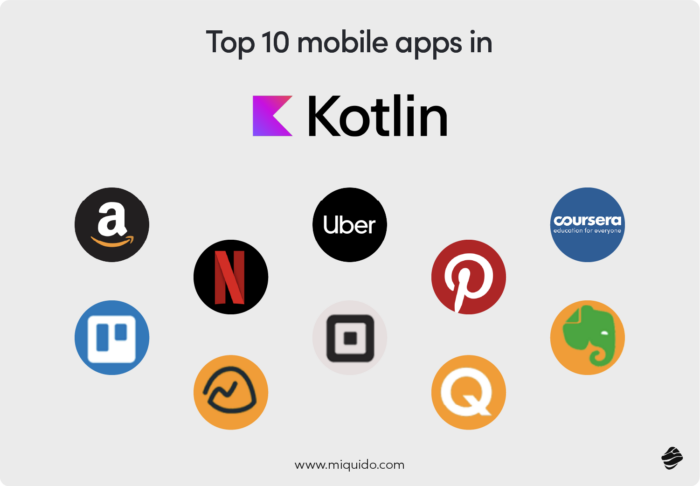
Cross-platform development with Flutter
Flutter, created by Google, is a 100% cross-platform framework dedicated to writing clean, native-like code simultaneously for Android and iOS applications. Since its release in 2017, Flutter has gained popularity due to its versatility and rapid implementation capabilities. Flutter supports a wide range of platforms, including mobile, web, and desktop, while still relying on native code.
One of Flutter’s standout features is its hot-reload functionality, which allows developers to see changes in their code in real-time without restarting the application. This feature, combined with an extensive widget library, enables the creation of highly customizable and visually appealing apps quickly and efficiently.
While Flutter is relatively young, it has matured rapidly due to market demands and an expanding community. It is already used by some of the world’s favorite brands, such as Google, Groupon, Philips, and more. At Miquido, we were among the first companies to adopt Flutter in our tech stack, using it to develop the Topline app for Abbey Road Studios, showcasing Flutter development potential in delivering high-quality cross-platform solutions.
Pros and cons of Swift, Kotlin vs Flutter for business owners and developers
Now that we’re done with the basics and you have a better understanding of what each language has to offer, it’s time to get more specific.
For those of you interested in the final outcome of your project, we made sure to include the business-oriented aspects of Kotlin, Swift, and Flutter. And for the tech whizzes out there, we also didn’t forget about the actual functionalities and specific features each language has to offer.
So buckle up! It’s time to choose the best language for your next digital product!
The advantages and disadvantages of Swift
| Advantages of Swift | Disadvantages of Swift |
|---|---|
| Apple OS features for all Apple platforms | The platform-specific code cannot be reused outside of the Apple ecosystem |
| Fast-forwarded access to App Store | High-quality specialists are rare to come by |
| Simplified code update upon new OS release | Limited tooling and technical background from non-mobile domains |
| Support of structural, object-oriented, function, actor programming | Easy to learn at first but is very hard to master the specifics |
| High app performance and optimisation | |
| Ongoing support from Apple |
Swift is a strong alternative to Objective-C – the former crown king of iOS development. It comes with some fantastic business-oriented benefits:
- Swift allows using the latest Apple OS features on Apple platforms (Apple actively promotes apps following their guidelines in ads, stores, and even during keynotes).
- It supports platform-specific APIs andy system extensions which allows you to invest in one shared code for all the Apple-powered platforms you want to target at once while maintaining their native feel at the same time
- Swift is also known to cause the least problems upon releases and app reviews. This is a very important point to keep in mind since Apple is very restrictive on app content, behaviour and API usage.
- It is designed in such a way, that if a new OS update introduces any significant software changes, the Swift code can be easily adapted thanks to its high compatibility.
- Compared to Objective-C and other native languages, Swift stands out with its immaculate app performance and optimisation when it comes to the launch time, resource usage (including battery) and the final size of app files.
As such, Swift is a convenient choice for pro-Apple digital solutions as it knows how to bypass the complex screening process and won’t fall victim to regular OS updates.
Yet, let’s not get carried away, because we still have two other languages to review and Swift comes with its share of drawbacks as well:
- Swift relies on platform-specific code which cannot be easily reused outside of the Apple ecosystem (e.g. for Android and web solutions). This is why, if you know you’ll be targeting non-Apple users it’s best to choose another technology for your product.
- Swift specialists need to rely on programming languages used almost exclusively for the Apple platform which causes them to be much less common than, let’s say, Java developers.
- Due to its limited applicability, Swift doesn’t have strong tooling and technical background from domains other than mobile. It sometimes results in a lack of tooling equivalent to other languages or their worse quality. With the lack of good industry standards compared to more popular languages (such as Java) there may occur difficulties with large and/or complex applications. However, it doesn’t mean that you can’t make big and complex apps natively – you can, it is simply more demanding in some cases.
Benefits and drawbacks of Kotlin
| Advantages of Kotlin | Disadvantages of Kotlin |
|---|---|
| Interoperability with Java | Harder to learn when compared to Java |
| Clean minimal code | Less helpful for clean builds |
| Open-source community git | Less highly skilled developers available |
| Simple syntax familiar for Java, Python, or even Swift programmers | |
| Helps developers avoid a lot of common bugs | |
| A safer alternative to Java | |
| Unique features such as asynchronous programming, scope and extension functions, string interpolation, etc. | |
| Kotlin Multiplatform |
When it comes to Kotlin, it is important to also mention Java – the old standard for Android (and other) mobile applications. So when we look at all the benefits of Java application development, it is important to highlight:
- Kotlin is interoperable with Java. It is consistent with Java and many other related frameworks and tools. This allows the developers to use Kotlin in Java projects and develop new features in Kotlin at the same time.
- Kotlin can reduce the amount of code enormously, thus providing you with a cleaner project that is easier to read, understand, and take over if necessary.
- Built and supported by JetBrains, the company behind the IDEs, such as Android Studio and IntelliJ, Kotlin is open-source, so the community has a big impact on new features and bug fixes.
- Kotlin’s syntax is simple and even a beginner developer can grasp it relatively quickly. At the same time, the language offers sophisticated powerful features for experienced programmers, so that everyone gets their share of fun.
- Kotlin helps developers avoid a lot of bugs that were very common in Java.
The compiler can identify every possible mistake at compile-time without any hassle. The syntax takes care of reducing the number of possible errors(e.g. Elvis Operator). As a result, it turns Kotlin into a safer alternative to Java.
At the same time, there are certain things to look out for while choosing Kotlin as your programming language of choice:
- Even though Kotlin and Java share a number of similarities, they have some prominent differences as well. Kotlin has a lot of new features that don’t exist in Java, which makes it a harder but much more modern language.
- Kotlin runs faster than Java in some cases, especially when doing incremental builds. But when it comes to clean builds, Java will always be faster.
Flutter: the good and the bad
| Advantages of Flutter | Disadvantages of Flutter |
|---|---|
| Very fast time-to-market | No support for Apple TV or Android TV |
| Wide platform support without additional costs | Lack of dedicated libraries for certain native features |
| UI-oriented programming | Web support is still work in progress |
| Strong support of the industry leaders (i.e. Google) | Services are more expensive compared to native programming |
| Simple architecture and ease of learning | Flutter apps tend to be larger in size compared to native apps |
| Increased program stability thanks to Sound null-safety built into the language | |
| Real-time changes in the code thanks to hot-reload | |
| Very fast compilation |
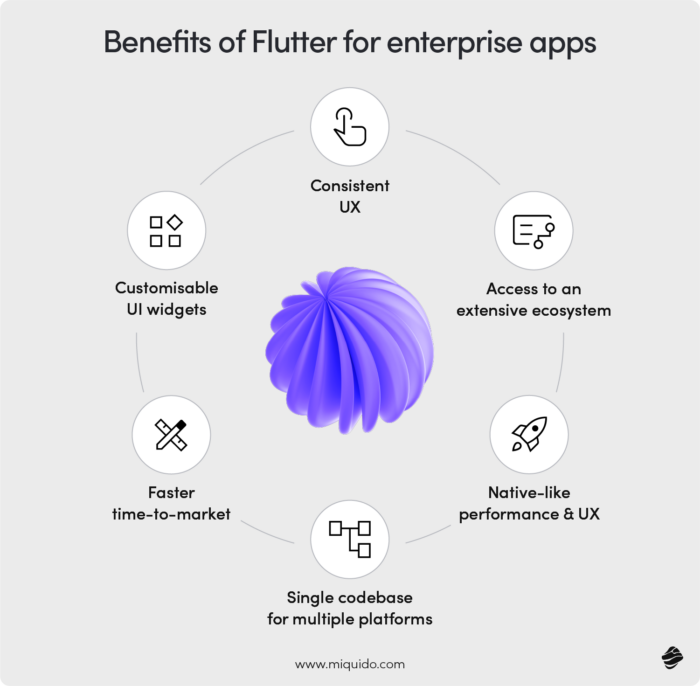
Flutter offers many great benefits for businesses, arguably even more so than alternative cross-platform frameworks. First of all, it is known for its remarkably fast time-to-market abilities. Due to both intuitive code syntax and a pleasant work environment for developers, projects written with Flutter hit the stores faster.
Ease of learning and development
Flutter is very easy to learn, which is why a company shouldn’t have a problem with retraining its current Android and iOS developers to use Flutter if such a need arises. Flutter is packed with unique features, such as hot-reload with state persistence, which allows a developer to see changes in their code in real-time without having to restart the app. Both the App Store and Google Play Store are known to treat Flutter-based apps kindly without any harsh pre-examination or extensive verification.
Swift vs Kotlin vs Flutter in App Development: Final Notes
As you can see, there are many factors you need to consider before deciding on a specific language for your next digital product. Far too many factors, perhaps. That’s why we advise our clients to trust the vendor with the solution.
Complexity and Considerations
Choosing the right technology for your mobile app development isn’t just about understanding the features and capabilities of Swift, Kotlin, or Flutter. It involves a deeper analysis of your project’s specific requirements, your team’s skill set, your target audience, and the long-term maintenance and scalability of your app. Each language and framework comes with its own set of strengths and weaknesses, and what works best for one project might not be suitable for another.
Vendor Expertise
Given the complexity involved, it’s often beneficial to leverage the expertise of experienced vendors. A professional development team can provide valuable insights into the most suitable technology for your project, ensuring that your app is not only functional but also efficient, scalable, and aligned with your business goals. Vendors have the advantage of having worked on numerous projects across different industries, giving them a broad perspective on what works best in various scenarios.
Personalized Consultation
If you found this article complex and would need a more in-depth consultation regarding the best technology for your project, we’ll be happy to help! Our team of experts can analyze your specific needs and recommend the most appropriate technology stack for your mobile app. Whether you’re looking to develop a high-performance native app for iOS or Android, or a versatile cross-platform solution, we have the knowledge and experience to guide you through the decision-making process.








